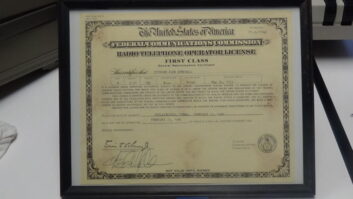
Do you love radio history? Are you intimately familiar with how broadcasting developed in a given city, and enjoy sharing that with others? Arcadia Publishing may want to hear from you.
Arcadia published its first history of a radio station in 2006, focusing on WNAX(AM) in South Dakota. It was co-authored by Stan Ray — who “grew up” in the transmitter building where his father worked as an engineer — and freelance writer Marilyn Kratz.
“We quickly realized we’d hit on something special,” says Katie Kellett, Arcadia’s director of sales for the North and MidAtlantic, of that book.

These broadcast titles are an offshoot of a series of photo books about local towns. “As the success of our ‘Images of America’ series has grown, we’ve been approached by historians all across the country with new ideas,” Kellett said.
“What started as a series of town histories developed to include sports, colleges and universities, architectural landmarks, fairs and festivals, lighthouses and other maritime interests, railroads and aviation, and the list goes on. … On a local level, these books strike a chord with residents who remember their favorite radio and television personalities from childhood. The covers of the books often showcase a beloved local broadcaster or perhaps a favorite program that aired on the station.”
Writers wanted
I’m a fan; I’ve mentioned the series here and on my blog at radioworld.com. Arcadia’s catalog now includes approximately 30 titles on radio and TV, with many more planned. These books essentially are photo essays, heavy on visuals and supported with brief but informative text. They’re wonderful to flip through.
A neat twist for me is that some authors have contributed to Radio World as well.
The new title “Hartford Radio” is by John Ramsey, who grew up listening to radio in Connecticut and has worked in the industry as an engineer since 1978. He’s GM of WWUH(FM) at the University of Hartford and chief engineer of WCCC(FM); he’s also webmaster of a Hartford history website and is chairman of SBE Chapter 14, as well as president of Torrington Community Radio Foundation, licensee of WAPJ(FM) and founder of the CT Radio Alliance.
John has shared tips in Radio World’s Workbench, and he wrote in RW in 2010 about visiting an unusual wind turbine.

Fresh out this month is “Bay Area Radio,” detailing the events and history of radio in the San Francisco region. The book covers the period 1902–1960. It has substantial coverage of NBC’s early activities on the West Coast, WWII shortwave broadcasting and the beginnings of the VOA. This is co-authored by radio historian John F. Schneider, whose historical broadcast pictures are well known to RW readers. Schneider shares the book author credit with the California Historical Radio Society and the Bay Area Radio Museum.
Whether it’s reading about “Doc” Herrold broadcasting in San Jose in 1909 or Bob Steele doing school closing announcements on WTIC in the 1950s (that’s Steele on the Hartford cover), you will enjoy these books, especially if you grew up in that city or have an appreciation for how radio has connected to its communities over the years. Other titles feature broadcasting in Birmingham, Ala.; Nashville and Chattanooga, Tenn.; Cincinnati; Harrisburg, Pa.; Philadelphia; and Pittsburgh. Some mix radio and TV, others focus on one or the other. I previously told you about Donna Halper’s “Boston Radio: 1920–2010.”
More cities are planned. Just in New York state, Arcadia has titles pending for Albany, Buffalo, New York City, Rochester and Syracuse. “Our next station-specific title in the works will cover KIDO in Boise, Idaho, and should be available in late 2012,” Kellett said. Stations with their own books already include WLS in Chicago; WHO in Des Moines, Iowa; and KMOX in St. Louis.
RW readers often have told me that too many radio stations have forgotten their own history. If so, this series represents a lovely counter to that trend.
And yes, Kellett says Arcadia actively seeks radio and television historians, “to work with us on photographic histories of their individual stations or on a more general broadcasting history of their city. This is an exciting area of growth for us.” Authors come from a variety of backgrounds, and many are first-time writers.
“For these books in particular, we are looking for someone with a passion for broadcasting history and someone who is intimately connected to the field.” Sounds like a Radio World reader to me.
If you are interested in learning about how to write for Arcadia, visit Radio World’s links page. We’ll point you to the company’s info for potential authors.










